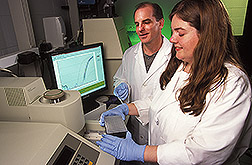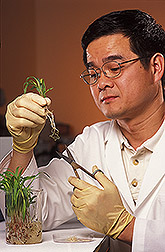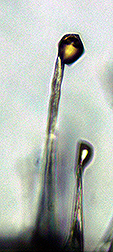Sorghum Needs Its Space, Too
|
|
How it guards itself may be key in crops’ battle against weeds.
Like people, plants need their space. The amount of room around them greatly influences how much sunlight they get, how large they grow, and how healthy they are.
And just like us, some plants are more protective than others of their space.
Scientists in the ARS Natural Products Utilization Research Unit at Oxford, Mississippi, are studying sorghum, one of the more assertive of these plants, as part of efforts to help food crops wage a better fight against an arch nemesis: weeds.
“Crops have been bred and engineered to defend against insects, nematodes, and diseases,” says plant physiologist Stephen Duke, the unit’s research leader. “But almost nothing has been done to help crops fend off weeds, other than making them resistant to synthetic herbicides. If major crops could be made to produce natural herbicides, use of synthetic pesticides would be significantly reduced.”
Many plants—and sorghum is one—possess “allelopathic” traits. That is, they exude substances called “phytotoxins” that keep encroaching plants at bay. Other allelopathic plants include black walnut, fescue, and rice.
|
|
Duke says he and his Oxford colleagues—molecular biologists Scott Baerson, Daniel Cook, and Zhiqiang Pan; plant physiologist Franck Dayan; and chemist Agnes Rimando—are studying sorghum “because its allelopathic properties are stronger than those of most other plants that show these traits.” Also, says Duke, it exudes sorgoleone, a compound that’s more active in fighting weeds than most others.
Adds Dayan, “We wanted something very active that’s produced by the root and root hairs in fairly high amounts. Nothing else we’ve seen fits these criteria as well as sorghum and sorgoleone do.”
Sorghum, which originated in Africa, is an important grain in much of the eastern hemisphere. Noted for its drought tolerance, it’s one of the world’s most popular cereal crops.
|
|
Getting Popular in the U.S.A.
In the United States, the crop is almost exclusively used for livestock forage, although it’s seeing an explosion in popularity among Americans lately due to its natural cancer-fighting compounds and its digestibility by people with gluten intolerance. In fact, scientists at ARS’s Hard Winter Wheat Quality Laboratory in Manhattan, Kansas, are assessing which sorghum varieties lend themselves to better loaves of bread and other baked goods. (See Agricultural Research, June 2004, "Move Over, Bossie! Sorghum's Not Just for Cows Anymore.") Some U.S. farmers, especially in the South, use sorghum as a cover crop to help control weeds.
Baerson says the researchers from the ARS unit, which is based at the University of Mississippi’s Oxford campus, are developing the basic information needed to genetically increase production of sorgoleone in sorghum.
“We used a known technique for isolating large quantities of root hair cells to explore sorgoleone’s chemical pathway and found genes that may encode the compound’s enzymes,” he says. “A cDNA library was then prepared from this material, containing copies of the more highly expressed RNA sequences in this cell type.” cDNA is composed of DNA strands that are complementary to a given messenger RNA (mRNA) strand. These mRNAs serve as a template for production of cDNA during reverse transcription.
From this material, University of Georgia professor Lee Pratt helped the team generate a DNA sequence database that contains more than 5,500 randomly selected sequences. The researchers then used data-mining software developed at the university to identify candidates that encode enzymes predicted to be involved in sorgoleone biosynthesis.
They further narrowed the candidate-gene list using real-time reverse transcription polymerase chain reaction (PCR), the most reliable method for detecting and measuring nucleic acid levels. “PCR enabled us to quickly determine which sequences were most highly expressed in root hair cells, where sorgoleone is made, compared with other parts of the plant,” says Baerson.
|
|
Transferring Allelopathy to Other Crops
Duke says this work may serve as an important step toward the ultimate goal: introducing allelopathic traits to crops.
“Allelopathy as a means of weed control has fascinated scientists since the early 20th century,” he says. “Germplasms with allelopathy traits have been well established in crops such as rice, barley, cucumber, and wheat, as well as sorghum. But, so far, researchers haven’t been able to develop commercial varieties that carry allelopathy traits.
“There are two methods for creating a more allelopathic crop: One is to enhance existing allelopathy potential, and the other is to insert genes to produce allelochemicals not found in the crop.” He says either approach is much more complicated than creating herbicide-resistant crops.
|
|
“In the first case, we must decide what compounds already made by the crop would be herbicidal if produced and exuded into the soil in sufficient amounts. Proving a compound’s toxicity to weeds is relatively simple. But it’s harder to prove that a compound coming from one plant actually inhibits growth of surrounding plants in a natural or agricultural setting.”
Other factors must be considered as well. “For one,” says Duke, “the probability of weeds developing resistance to allelochemicals is unknown. And most important, we need to be sure that allelochemicals don’t harm nontarget organisms, including humans.”
But the advantages would be profound. “Use of synthetic herbicides would be curtailed. Also, allelopathy is continuous, unlike the intermittent relief from weeds offered by herbicides. And finally, allelopathic effects are less weather-dependent and more environmentally friendly than synthetic methods. Such an advance would be a tremendous benefit to farmers in both developed and developing countries,” says Dayan.
Still, Duke says, it’s unlikely that allelopathy will totally replace herbicides in weed control. “Herbicides are highly effective. But if naturally protective traits could even marginally reduce herbicide use, the monetary savings to farmers over time would be significant and the benefit to the environment would be highly desirable.”—By Luis Pons, Agricultural Research Service Information Staff.
This research is part of Plant Biological and Molecular Processes, an ARS National Program (#302) described on the World Wide Web at www.nps.ars.usda.gov.
Stephen O. Duke is in the ARS Natural Products Utilization Research Unit, P.O. Box 8048, Oxford, MS 38677; phone (662) 915-1036, fax (662) 915-1035.
"Sorghum Needs Its Space, Too" was published in the May 2005 issue of Agricultural Research magazine.











